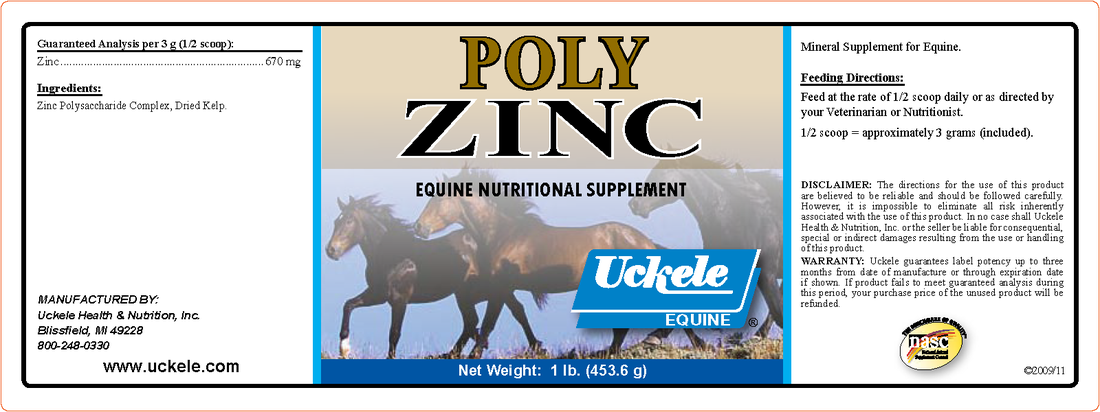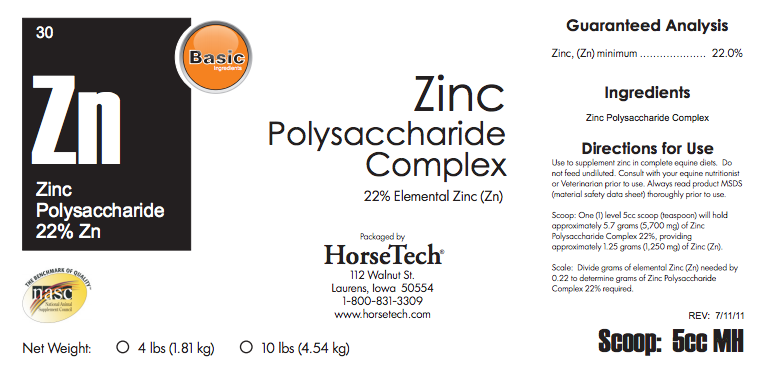Attention iOS users: You will not be able to view tables on this page without Adobe Flash Player, which is not supported by iOS. You can click on links to tables, or install a web browser with Flash support, such as Puffin (free download from Apps Store but only 14 day free trial with Flash support).
Desktop users: You cannot print from the Scribd table format. For a printed copy, click on the link to the table and print from your browser.
Desktop users: You cannot print from the Scribd table format. For a printed copy, click on the link to the table and print from your browser.
Part 3. Choosing and formulating your own mineral supplements
We are now ready to choose mineral supplements and determine the amount required to correct deficiencies in your horse’s diet. Supplements are usually not available as uncombined elements (e.g., Calcium) but occur with other elements in chemical compounds (e.g., calcium carbonate). In our example, we are going to target deficiencies in Cu, Zn and Mn with single ingredients rather than commercial mixtures, which can contain minerals and calories that your horse does not need. In addition, unless commercial products are formulated specifically for your local area, supplement amounts will usually not be correct.
Listed below are supplements recommended by Eleanor Kellon, VMD (Carol Layton, Balanced Equine Nutrition, pers. comm.). It is important to use compounds that are low in iron and easily absorbed in the digestive tract. If possible, avoid antagonistic effects, e.g., iron/zinc and copper/sulfur.
Table 1. Recommended mineral supplements
____________________________________________________
Ca: Calcium chloride, or calcium carbonate.
P: Sodium phosphate or monosodium phosphate. Monocalcium phosphates and dicalcium phosphates are not recommended because of high iron content.
Mg: Magnesium carbonate, if you have excessive amounts of iron in your forage and soil. The oxide MgO can contain 5000 ppm, or 5 mg/g iron. If you prefer to use MgO, purchase high-purity grade. Avoid magnesium sulfate (Epsom salts). It is poorly absorbed and can cause diarrhea.
Cu: Copper polysaccharide (poly copper). Copper sulfate has the potential to cause more interference with copper absorption, especially if your water supply is high in sulfates (i.e., antagonistic effects). It is uncertain whether poly Cu is more bioavailable (absorbable) than the sulfate; however, the poly "coating" (Cu ion weakly bonded within polysaccharide complex) could inhibit Cu precipitation by excess sulfates in the small intestine. Copper sulfate can be used if poly copper is not available.
Zn: Zinc sulfate or zinc polysaccharide (poly zinc). Zn bioavailability is poor with zinc oxide.
Mn: Manganese sulfate.
Na and Cl: Loose white salt, or sea salt, e.g., Redmond salt.
Se: Selenium-enriched yeast (Se replaces Sulfur (S) in amino acids, e.g., selenomethionine). Se-yeast is more bioavailable, better retained and less toxic than inorganic selenium compounds (sodium selenite and sodium selenate).
________________________________________________________
We are now ready to choose mineral supplements and determine the amount required to correct deficiencies in your horse’s diet. Supplements are usually not available as uncombined elements (e.g., Calcium) but occur with other elements in chemical compounds (e.g., calcium carbonate). In our example, we are going to target deficiencies in Cu, Zn and Mn with single ingredients rather than commercial mixtures, which can contain minerals and calories that your horse does not need. In addition, unless commercial products are formulated specifically for your local area, supplement amounts will usually not be correct.
Listed below are supplements recommended by Eleanor Kellon, VMD (Carol Layton, Balanced Equine Nutrition, pers. comm.). It is important to use compounds that are low in iron and easily absorbed in the digestive tract. If possible, avoid antagonistic effects, e.g., iron/zinc and copper/sulfur.
Table 1. Recommended mineral supplements
____________________________________________________
Ca: Calcium chloride, or calcium carbonate.
P: Sodium phosphate or monosodium phosphate. Monocalcium phosphates and dicalcium phosphates are not recommended because of high iron content.
Mg: Magnesium carbonate, if you have excessive amounts of iron in your forage and soil. The oxide MgO can contain 5000 ppm, or 5 mg/g iron. If you prefer to use MgO, purchase high-purity grade. Avoid magnesium sulfate (Epsom salts). It is poorly absorbed and can cause diarrhea.
Cu: Copper polysaccharide (poly copper). Copper sulfate has the potential to cause more interference with copper absorption, especially if your water supply is high in sulfates (i.e., antagonistic effects). It is uncertain whether poly Cu is more bioavailable (absorbable) than the sulfate; however, the poly "coating" (Cu ion weakly bonded within polysaccharide complex) could inhibit Cu precipitation by excess sulfates in the small intestine. Copper sulfate can be used if poly copper is not available.
Zn: Zinc sulfate or zinc polysaccharide (poly zinc). Zn bioavailability is poor with zinc oxide.
Mn: Manganese sulfate.
Na and Cl: Loose white salt, or sea salt, e.g., Redmond salt.
Se: Selenium-enriched yeast (Se replaces Sulfur (S) in amino acids, e.g., selenomethionine). Se-yeast is more bioavailable, better retained and less toxic than inorganic selenium compounds (sodium selenite and sodium selenate).
________________________________________________________
Your browser does not support viewing this document. Click here to download the document.
The relatively high iron (Fe) content of Redmond salt might be of concern since we are trying to minimize the amount of dietary Fe. From the trace element analysis, the minimum and average Fe concentrations are 300 ppm and 500 ppm, respectively. Remember that 1 ppm = 1 mg/kg. For a daily supplement of 2 tablespoons = 1 fl ounce ~ 28 g salt (measured weight), Fe dietary contribution from Redmond salt for the average concentration is only 14 mg (500 mg/kg x 0.028 kg salt). This is a very small amount relative to that for grass hay (760 mg) and pasture (1260 mg) (Table 4, Part 2).
In contrast to white salt, Redmond salt is ancient sea salt formed about 200 million years ago at the present location of Utah. Redmond salt (#10 Fine) is available locally from Georgetown Feed, Georgetown, Indiana.
For our Cu/Zn supplements, we chose poly Cu and poly Zn (powder) rather than the sulfate analogs. Table 2 shows the supplement calculation for hay and pasture from Central, Indiana.
Your browser does not support viewing this document. Click here to download the document.
As an example, let’s work through the supplement calculation in scoops using the product label for poly Zn from Uckele Health and Nutrition.
For this product, 0.5 scoop poly Zn = 3 g compound = 670 mg Zn (670 mg/3000 mg x 100 = 22% Zn). Therefore, you would need to add ~0.28 scoop to balance the hay-only diet (0.28/0.5 scoop x 3 g poly Zn = 1.68 g = 1680 mg). For poly Cu, 0.5 scoop = 2.5 g compound = 310 mg Cu (12.4% Cu). In this case, add ~0.18 scoop (0.18/0.5 scoop x 2.5 g poly Cu = 0.9 g = 900 mg). As you can see, it’s impossible to measure out accurate amounts using the “scoop method”. It’s easier and more accurate to use an inexpensive gram scale.
Some labels are more user friendly than others. A good example is this poly Zn label from HorseTech. The "Directions for Use" are very explicit and explain in detail how to calculate the amount of poly Zn compound required to balance the Zn deficiency in Table 2 (click on image and view last paragraph under "Directions for Use"). It's the same procedure given in the footnote to Table 2.
Some labels are more user friendly than others. A good example is this poly Zn label from HorseTech. The "Directions for Use" are very explicit and explain in detail how to calculate the amount of poly Zn compound required to balance the Zn deficiency in Table 2 (click on image and view last paragraph under "Directions for Use"). It's the same procedure given in the footnote to Table 2.
Supplements can be incorporated in wet non-molasses beet pulp as part of the daily ration. Cu and Zn polysaccharides as single ingredients are somewhat bitter. Begin supplementing with small amounts and gradually increase to the recommended level. Initially, you might have to use a flavor enhancer, such as CocoSoya (coconut and soybean oils), until your horse becomes accustomed to the taste of the beet pulp mixture. For forage with very high iron contents (>> 200 ppm), you can reduce the amounts of polysaccharides required and improve palatability by relaxing the 4:1 Fe:Cu. The 4:1 Fe:Cu ratio is ideal but horses can tolerate ratios up to 10:1 (Eleanor Kellon, VMD, Equine Nutrition Courses).
You might be wondering if locally available feeds and mineral supplements compensate for trace mineral deficits in grass hay (Table 2). Table 3 indicates that most popular horse products will not balance Cu and Zn deficiencies in our grass hay example for a Fe:Cu:Zn ratio 4:1:3.
For hay, or pasture, with higher iron concentrations, mineral deficits for these commercial products will increase. For example, the mineral deficit for Dumor Vitamin Gold will approximately double for our pasture example in Table 2 (126 ppm Fe).
You might be wondering if locally available feeds and mineral supplements compensate for trace mineral deficits in grass hay (Table 2). Table 3 indicates that most popular horse products will not balance Cu and Zn deficiencies in our grass hay example for a Fe:Cu:Zn ratio 4:1:3.
For hay, or pasture, with higher iron concentrations, mineral deficits for these commercial products will increase. For example, the mineral deficit for Dumor Vitamin Gold will approximately double for our pasture example in Table 2 (126 ppm Fe).
Your browser does not support viewing this document. Click here to download the document.
Please consult with your veterinarian, or equine nutritionist, before formulating your own supplements, or changing your horse's diet.
Copyright George Lager, 2011-2016. All Rights Reserved (®)

